5 Best Star Trackers for DSLR in 2024 [Buyer’s Guide]
People are saying that star tracking equipment can be an introduction to ‘real’ astrophotography. While for many people, that was the case, in my opinion, you can start star tracking and continuously improve on your approach and techniques until you get the most magnificent images, real pro results.
In fact, many professional photographers are doing just that, star tracking, using different lenses, different techniques, and locations to get the perfect results. Star track photography is just a small segment of astrophotography.
There is no best star tracker for DSLR; your devotion and technique will give you better results than the most advanced setups. Whether you call them ‘sky trackers,’ ‘tracking camera mounts,’ or any other similar combination, they all do the same thing.
They essentially compensate for the apparent rotation of the night sky that we see here on Earth to freeze a deep sky object or the night sky overall in its place for long exposure photography.
We Recommend
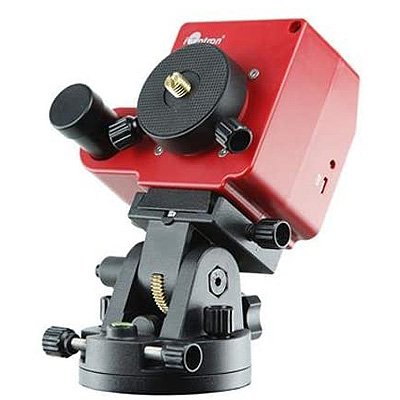
Best for beginners
iOptron
SkyTracker Pro
Highest weight limit
Sky-Watcher
Star Adventurer
Best for travel
iOptron
SkyGuider Pro
How does a star tracker work?
Every star tracking mounts, the way they work is that they have a small right ascension (RA) motor in them. They slowly turned with the motion of the night sky in the RA axis. The RA axis must be aligned with the Earth’s rotation axis by polar aligning the sky tracker.
When it’s on, it’s slowly rotating at a sidereal rate that matches the movement of the night sky. To get that to happen properly, you need to polar align them out. The way these devices handle the polar alignment is a really important factor to consider when thinking about the overall user experience of the mount.
Quick tip: For wide-angle photography, you don’t need a very precise polar alignment.
Almost all sky trackers have a built-in illuminated polar finderscope on the side, so just get behind it and adjust the declination base (wedge) and aim at the North Star (Polaris) in the northern hemisphere. Polar alignment in the southern hemisphere is similar, but you are looking for different stars.
Most of the mounts have a built-in illuminated polar finderscope, and that’s essential for getting set up quickly. User experience can vary between different models, but they all do a good job of what they are meant for according to their capabilities and features.
Quick tip: Sometimes, using them in a completely unorthodox way can give you unique results while filming time-lapse nightscapes.
Related: 5 Best Cameras for Astrophotography in 2020 [+Lens Options]
How to use a star tracker for astrophotography?
Star trackers are probably the easiest astrophotography gear out there. They are easy to use, lightweight, very compact and portable, and very often more compact than most DSLRs.
You can use them for various photography and videography purposes like long exposure nightscapes of the stars and the Milky Way, telephoto long exposure of deep-sky objects, time-lapses of the sidereal sky, the Moon and the Sun, horizon panning time-lapses, etc.
The gear can be set up very fast and easy. All you need is a tripod, a star tracker and a camera. You can use everything from wide-angle action cameras, phone cameras for time-lapses to DSLRs with a wide-angle lens or telephoto lens for deep-sky photography.
While setting up the equipment, you have to level the tripod. The easiest way is if you have a flat surface, but if you are in the field, then you have to use the bubble levels on the tripod.
Then you attach the wedge that will be set at your specific angle (declination) depending on your geographical latitude. On the wedge comes the right ascension motorized head and on top of that, you attach the appropriate camera with the desired lens. After you set up the star tracker, you can start taking long-exposure images of your favorite part of the (night) sky.
How much does your setup weigh?
For every star tracker, there is a quoted payload weight limit for the gear it can carry. Though most of the star trackers can withstand most of the regular photography setups, the most advanced ones can carry even larger refractor astronomy telescopes.
In my experience, most of the star trackers can carry at least 20% more than the quoted payload weight limit. Never the less you should be cautious when purchasing your favorite star tracker if you plan to use it with larger, heavier lenses.
If you put more weight than the servo motor can stand, you might lose the tracking ability, and your images can be smudged with some trails on them. This might happen even if you are below the weight limit, but the batteries are near the end of life.
Equipment gear for Milky Way photography and nightscapes is usually a lot lighter and most star tracker can carry regular DSLR setup:
- Nikon D750 FX-format Digital SLR Camera Body with battery – 1.9 lbs. (840 g.)
- Rokinon 14mm f/2.8 IF ED UMC Ultra Wide Angle = 1.2 lbs. (550 g.)
- Total = 3.1 lbs. (1390 g.)
Equipment for deep-sky photography is quite heavier because of the heavy lens or scopes that must be used for greater magnification (zoom factor):
- Canon EOS 7D Mark II Digital SLR Camera with battery grip and 2 batteries = 2.4 lbs. (1110 g.)
- Canon EF 100-400mm f/4.5-5.6L IS II USM Lens = 3.5 lbs. (1550 g.)
- Total = 5.9 lbs. (2660 g.)
How to choose the right star tracker?
There are several specifications and feature that you should look for when purchasing the best star tracker for your needs:
- Payload capacity – this is probably the most important characteristic you should pay attention to when purchasing a star tracker. If your star tracker can’t function properly with your desired equipment, then it won’t be of any use.
- Power – there are several types of power storage for the star trackers.
- With built-in batteries – most useful, compact, and clean construction. You’ll never forget the batteries and the capacity is intended to last a whole night.
- With an internal battery tray/compartment – you should purchase a new set of batteries every time you use the star tracker or obtain rechargeable batteries.
- With external battery source – the battery source is plugged in via cable that can be tangled around the mount or the motorized head itself.
- Mechanical clockwork – uses manual spring winder for mount rotation.
- Weight – portability is probably important if you travel a lot or you want it in your camera bag the whole time. If that’s true, portability is your thing, and you should opt for the most compact tracker.
- Maximal useful focal length – more precise the tracker is, the longer focal length lens/telescope you can use with it. If you plan to use it for deep sky astrophotography, then pay attention to this spec.
- Runtime – also very important characteristic is how long can you use it with one set of batteries/charge. If you have to change batteries or recharge the unit after a while, that means you can’t use it for longer time-lapses.
Star tracker for DSLR
1. Omegon Mount Mini Track LX2
The mechanical star tracker from Omegon is a lightweight device that does not require an app for polar alignment and does not need batteries to operate.
Is it too good to be true? Yes, but that’s about all you can do with it. There are no different speeds nor the Moon and Sun tracking.
There is no hemisphere switch, which means you can operate it in the northern hemisphere only.
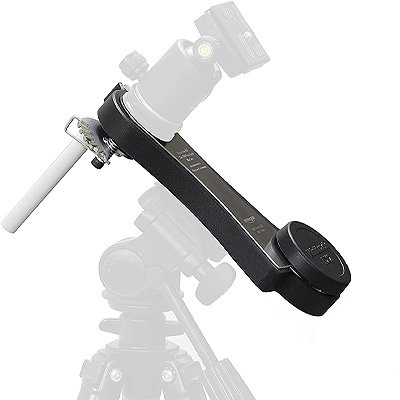
This is a nice camera mount that attaches to any tripod and it’s tracking stars with great accuracy. It is perfect for anyone who enjoys wide-field imaging of the night sky, time-lapses, and nighttime nature photography.
This is the easiest and most affordable product to get amazing photographs of our galaxy, the Milky Way, large constellations like Orion or deep-sky objects like the Andromeda galaxy and Rho Ophiuchi. The mount is capable of tracking the sky for one full hour before it needs to be reset.
It works like a clockwork timer, and you must wind up the device with the knob when you start shooting. Once the full hour has passed, the timer will ring, letting you know that the mount is about to stop tracking. You can always carry it in your camera bag or even better in your tripod bag.
Check the price of Omegon Mount Mini Track LX2 here
What we liked
- Ultra-lightweight
- Ultra-compact design
- No batteries to operate
- Quick assembly
- Easy polar alignment
- Amazing for wide-angle shots and time-lapses
- Rings before stops tracking
- Low price for basic equipment
What we didn’t like
- Low payload capacity
- No counterweight option
- 1 hour of runtime
- Works for northern hemisphere only
Payload capacity: 4.4 lbs. (2 kg)
Power: Mechanical clockwork
Weight: 1 lb. (450 g)
Max. focal length: 150 mm
Runtime: 1 h
2. Sky-Watcher Star Adventurer Mini (SAM)
This is the only star tracker with smartphone capabilities, which sounds great, but unfortunately, this is where I have a problem with this tracker.
It’s not the connectivity, but unlike every other star tracker on the market that has buttons on the back to control the tracking speed and pretty much all you have to do is turn on, the tracker will start tracking.
With the mini, you have to connect to your smartphone; you have to connect to the app, you have to use the app to set the tracking speed.
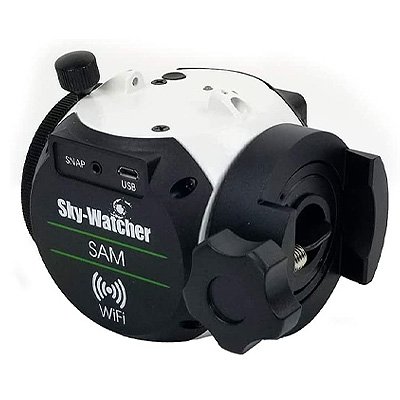
Unless you do all that, the tracker is just useless. It’s a paperweight, so it’s going to be a shame that it can’t even use the tracker unless you have the smartphone connected and you’re using the app.
The free app download on Android and iPhone will control all of the functions on the mini and you can even connect your camera to it, using a snap cable and control your camera shutter speed as well as the interval. That’s a nice bonus feature. As well now in the app, you can control different time-lapse features your tracking speed and a whole lot more.
The Mini takes all the same accessories as the normal Star Adventurer, like the same base, same declination bracket, same counterweight, which is kind of nice. You know if you end up going from one or the other, you’ll have all the same components, so keep that in mind.
Check the price of Sky-Watcher Star Adventurer Mini (SAM) here
What we liked
- Lightweight mount
- Very compact
- Wi-Fi smartphone capabilities
- App capabilities and options
- Great precision
- Good build quality
- Great for wide-angle shots and time-lapses
What we didn’t like
- Low payload capacity
- Flimsy polar illuminator
- The polar viewfinder is not necessary
- Low quality of snap cable to connect to the camera
Payload capacity: 3 lbs. (1.4 kg)
Power: 4 AA batteries or external power bank via mini-USB (not included)
Weight: 1.4 lbs. (650 g)
Max. focal length: 200 mm
Runtime: 24 h
3. iOptron SkyTracker Pro Camera Mount
If you don’t know what to buy, then purchase this one.
iOptron SkyTracker Pro is the most affordable and it’s capable of taking incredible images with a telephoto lens of up to 200 mm focal length.
In my opinion, that’s enough for most of the beginners to capture the beauty of the starry night.
Some are saying that this is an entry-level star tracker, but this is a very powerful tool for photographing nightscapes and large portions of the sky.

This is amazing for long exposure shots and wide-angle night sky panoramas. With the AccuAlign Illuminated Polar Scope, the polar alignment is very fast and easy. It has most of the basic options and rotating speeds for great star tracking experience.
It has a very low payload capacity without the counterweight, and that’s fine, just don’t plan to mount a larger telephoto lens or telescopes on it.
Check the price of iOptron SkyTracker Pro Camera Mount here
What we liked
- Affordable price
- Great value
- Portability
- Easy polar alignment
- Small form factor
- iOptron app
- Silent servo motor
- Four tracking speeds
What we didn’t like
- Low payload capacity without counterweight
- Poor design counterweight accessories
- Accessories not included
Payload capacity: 2.6 lbs. (1.2 kg) with counterweight up to 6.6 lbs (3 kg)
Power: Internal rechargeable battery
Weight: 2.6 lbs. (1.2 kg)
Max. focal length: 200 mm
Runtime: 24 h
4. Sky-Watcher Star Adventurer Pro Pack
Probably the largest star tracker on the market, with performances, it’s comparable to iOptron SkyGuider Pro, but at a much lower price.
It also has an 11-pound weight limit so you can add quite a bit of camera gear on here and still get great results.
The problem I do have with the Sky-Watcher’s Star Adventurer is that it’s by far the largest star tracker, so it’s going to be hard to fit in your regular camera bag.
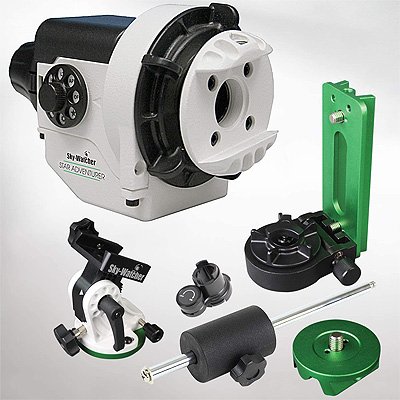
It’s also quite heavy and for those reasons alone, it’s just kind of a pain to take it anywhere. The built-in AA battery compartment provides reliable mobile power for up to 72 hours, and an additional 5V mini-USB input allows for external power source using a cell phone charger or similar power banks.
There is no battery meter, so in my experience, you keep an eye on those batteries and change all 4 of them every time. The great things though about this mount is the declination bracket and the whole counterweight system I really like.
How well-designed this is, you can just move the whole thing up or down to get more leverage and when you attach a telephoto lens directly or a telescope directly to the declination bracket, it’s just a breeze to use. If you plan to use a telephoto lens or telescopes, this star tracker is recommended.
Check the price of Sky-Watcher Star Adventurer Pro Pack here
What we liked
- Low price
- Ease of use
- Pretty long runtime
- Great payload capacity
- Nice design
- All accessories included
- Large maximum focal length
- Great quality base (wedge)
What we didn’t like
- No battery meter
- No power bank included
- Portability
- Heavyweight
Payload capacity: 11 lbs. (5 kg)
Power: 4 AA batteries or external power bank via mini-USB (not included)
Weight: 8.9 lbs. (4 kg)
Max. focal length: 600 mm
Runtime: 72 h
5. iOptron SkyGuider Pro Camera Mount Full Package
When traveling, the SkyGuider Pro is my choice every time because of that rechargeable Li-Ion battery inside that gives you a lot of portability.
If you couple it with a lightweight carbon-fiber tripod, you’ll get a perfect traveling star tracker. The mount is very portable and can carry enough payload for any reasonable, useful setup.
You can set it up and polar aligned in a couple of minutes.
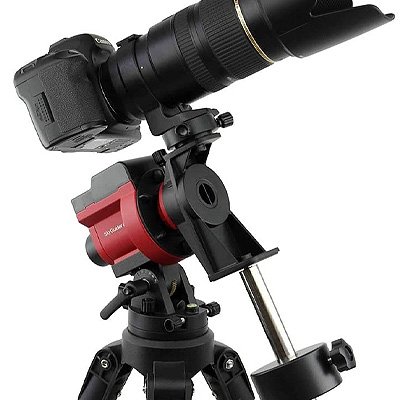
The clutch mechanism for the ball head gives you a more secure connection rather than just some screws which some of the other trackers have. This is more than enough; you’ll be very happy with it.
If you want to start getting into more deep-sky astrophotography using telephoto lenses or a small telescope and you want auto-guiding, the sky guider Pro is the obvious choice and well worth the money.
The only problem I have with this mount is the low-quality base wedge, looks dodgy, the screws are also a bit loos if you point it at more than 50° declination.
Check the price of iOptron SkyGuider Pro Camera Mount Full Package here
What we liked
- Build quality
- Portability
- Internal battery
- High precision
- Long runtime
- Large payload
- Ease of use
- A clutch mechanism for the ball head
- Design
What we didn’t like
- High price
- Short counterweight bar
- Lose eyepiece on the scope
Payload capacity: 11 lbs. (5 kg)
Power: Internal rechargeable battery
Weight: 3.2 lbs. (1.5 kg)
Max. focal length: 400 mm
Runtime: 20 h
Also read:

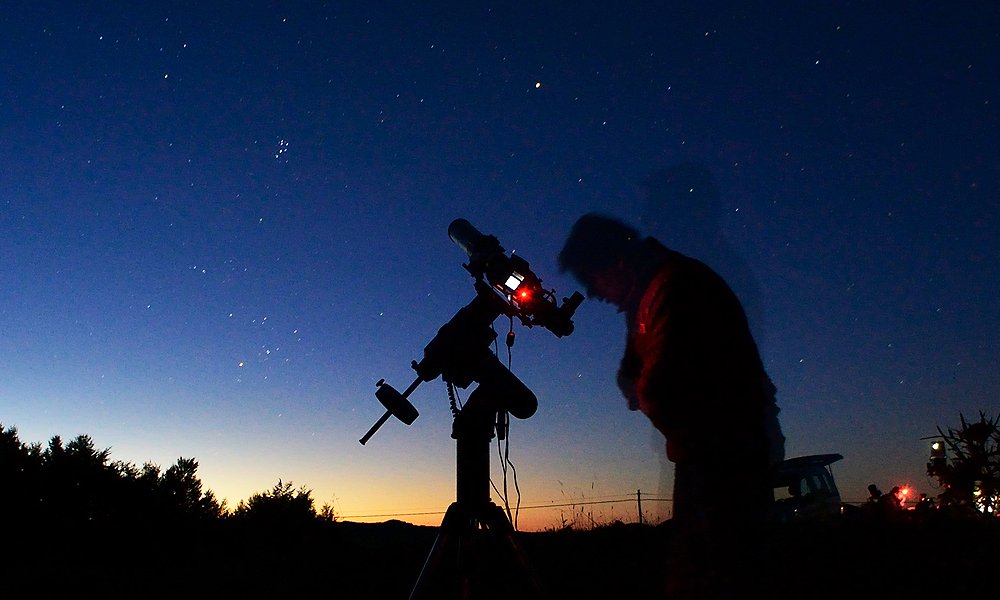
![10 Best Astronomy Laser Pointers Worth the Money [2024]](https://www.planetguide.net/wp-content/uploads/2020/01/astronomy-laser-pointer-768x461.jpg)
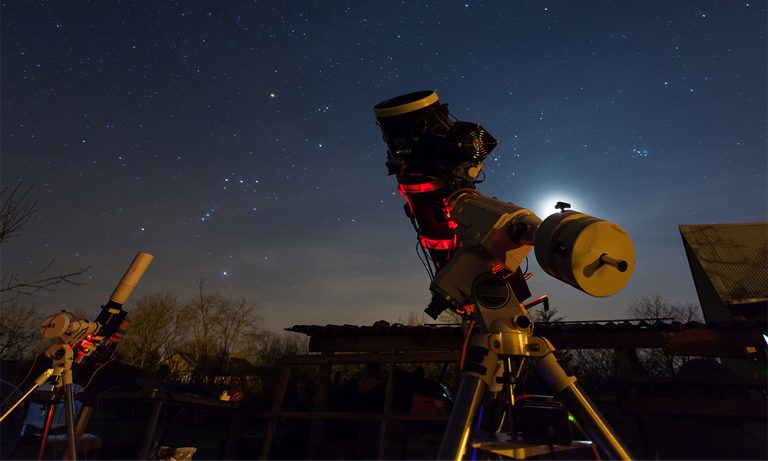
![5 Best Telescopes for Astrophotography in 2024 [+Mount]](https://www.planetguide.net/wp-content/uploads/2019/12/Depositphotos_95116882_l-2015-768x480.jpg)